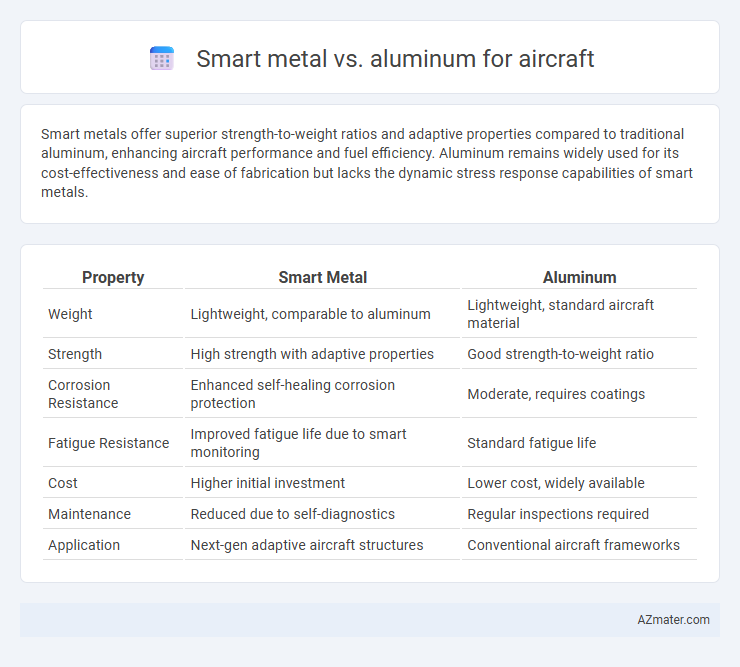Smart metals offer superior strength-to-weight ratios and adaptive properties compared to traditional aluminum, enhancing aircraft performance and fuel efficiency. Aluminum remains widely used for its cost-effectiveness and ease of fabrication but lacks the dynamic stress response capabilities of smart metals.
Table of Comparison
| Property | Smart Metal | Aluminum |
|---|---|---|
| Weight | Lightweight, comparable to aluminum | Lightweight, standard aircraft material |
| Strength | High strength with adaptive properties | Good strength-to-weight ratio |
| Corrosion Resistance | Enhanced self-healing corrosion protection | Moderate, requires coatings |
| Fatigue Resistance | Improved fatigue life due to smart monitoring | Standard fatigue life |
| Cost | Higher initial investment | Lower cost, widely available |
| Maintenance | Reduced due to self-diagnostics | Regular inspections required |
| Application | Next-gen adaptive aircraft structures | Conventional aircraft frameworks |
Introduction to Aircraft Materials: Smart Metal and Aluminum
Smart metals in aircraft, such as shape memory alloys, offer adaptive properties that enhance structural performance and damage tolerance. Aluminum remains a dominant aircraft material due to its lightweight, high strength-to-weight ratio, and corrosion resistance. Combining aluminum with smart metals enables innovative applications in morphing structures and real-time stress monitoring for improved flight safety and efficiency.
Evolution of Metal Usage in Aerospace Engineering
Smart metals, such as shape memory alloys and piezoelectric metals, have revolutionized aerospace engineering by enhancing adaptability and reducing structural weight, unlike traditional aluminum alloys widely used for their strength-to-weight ratio and corrosion resistance. The evolution from predominantly aluminum to integrating smart metals marks a significant advancement in performance optimization, enabling adaptive morphing structures and improved fuel efficiency. This shift reflects ongoing research in materials science aiming to meet the increasing demands for lightweight, high-strength, and multifunctional materials in modern aircraft design.
Composition and Properties: Smart Metal vs. Aluminum
Smart metals in aircraft, often composed of shape memory alloys like nickel-titanium (NiTi), exhibit unique properties such as superelasticity and the ability to return to their original shape after deformation, enhancing structural adaptability. Aluminum, primarily composed of aluminum with small amounts of copper, magnesium, and zinc, provides high strength-to-weight ratio, corrosion resistance, and excellent machinability, making it a traditional choice for airframe construction. The key difference lies in smart metals' dynamic responsiveness to stress and temperature changes, whereas aluminum offers stable mechanical properties with lightweight durability.
Strength-to-Weight Ratio Comparison
Smart metals, such as shape memory alloys, offer superior strength-to-weight ratios compared to traditional aluminum alloys used in aircraft, enabling enhanced structural performance and fatigue resistance while minimizing overall weight. Aluminum remains favorable for its low density and cost-effectiveness but lacks the adaptive properties and higher tensile strength provided by smart metals, which can enhance load-bearing capacity and impact resistance. The advanced capabilities of smart metals improve aircraft efficiency by reducing weight without compromising strength, leading to better fuel economy and increased payload capacity.
Corrosion Resistance and Durability
Smart metals, often incorporating advanced coatings or alloying elements, provide superior corrosion resistance compared to traditional aluminum used in aircraft, significantly reducing maintenance needs and extending service life. Aluminum alloys, while lightweight and durable, are more susceptible to oxidation and corrosion without protective treatments, which can compromise structural integrity over time. The enhanced durability of smart metals under harsh environmental conditions makes them increasingly preferred for critical aircraft components exposed to moisture and varying temperatures.
Cost Analysis: Manufacturing and Maintenance
Smart metals, such as shape memory alloys, often incur higher initial manufacturing costs compared to aluminum due to complex processing techniques and specialized equipment requirements. Aluminum remains favored in aircraft structures for its cost-effective machining, availability, and lightweight properties that reduce fuel consumption over time. Maintenance expenses for smart metals can be lower due to their self-healing characteristics, but overall lifecycle costs depend on application-specific performance and long-term durability in aerospace environments.
Impact on Fuel Efficiency and Environmental Sustainability
Smart metals in aircraft construction offer significant benefits over traditional aluminum by improving fuel efficiency through adaptive load management and weight reduction. These materials, often incorporating shape memory alloys or composites with embedded sensors, enable real-time structural adjustments that reduce drag and enhance aerodynamic performance. The resulting decrease in fuel consumption leads to lower greenhouse gas emissions, promoting environmental sustainability in the aviation industry.
Technological Advancements in Smart Metals
Smart metals, such as shape memory alloys (SMAs), exhibit exceptional adaptability and self-healing properties, revolutionizing aircraft design by enhancing structural integrity and reducing maintenance costs. Compared to traditional aluminum, these materials respond dynamically to stress and temperature changes, enabling real-time aerodynamic adjustments that improve fuel efficiency. Recent advancements in nanotechnology and computational modeling have accelerated the development of smart metals, allowing for precise control of their mechanical and thermal behaviors in aerospace applications.
Safety and Reliability in Aviation Applications
Smart metals, such as shape memory alloys, offer enhanced safety and reliability in aviation due to their ability to recover original shapes after deformation, reducing structural fatigue and damage. Aluminum remains widely valued for its lightweight, corrosion resistance, and proven durability in aircraft construction, ensuring consistent performance under varied stress conditions. Integrating smart metal technologies with traditional aluminum materials can improve aircraft structural integrity and real-time damage detection, advancing overall aviation safety standards.
Future Prospects: Smart Metals Superseding Aluminum?
Smart metals, characterized by shape memory and self-healing properties, offer significant advantages over traditional aluminum in aircraft manufacturing through enhanced durability and adaptive structural integrity. These advanced alloys enable reduced maintenance costs and improved fuel efficiency by responding dynamically to stress and damage. As aerospace innovation advances, smart metals are poised to supersede aluminum by enabling lighter, more resilient, and intelligent airframes vital for next-generation aircraft design.

Infographic: Smart metal vs Aluminum for Aircraft
 azmater.com
azmater.com